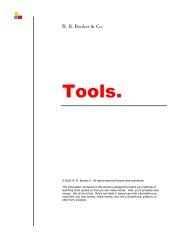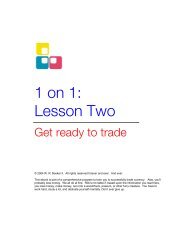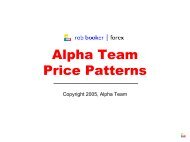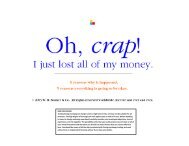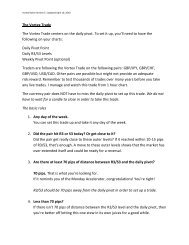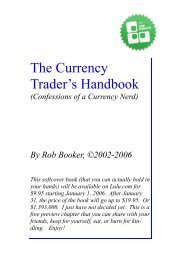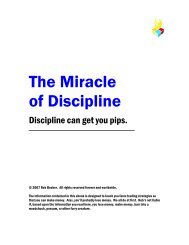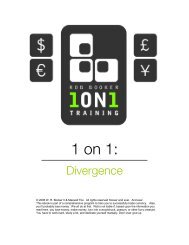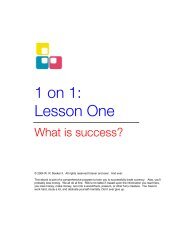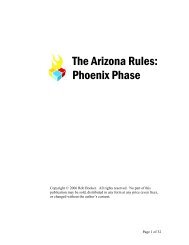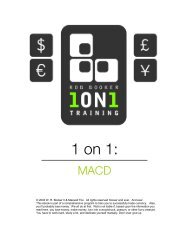The Arizona Rules - Rob Booker
The Arizona Rules - Rob Booker
The Arizona Rules - Rob Booker
Create successful ePaper yourself
Turn your PDF publications into a flip-book with our unique Google optimized e-Paper software.
<strong>The</strong> <strong>Arizona</strong> <strong>Rules</strong><br />
Copyright © 2007 <strong>Rob</strong> <strong>Booker</strong>. All rights reserved. No part of this<br />
publication may be sold, distributed in any form at any price (even free),<br />
or changed without the author’s consent.<br />
Page 1 of 26
Guiding Principles<br />
We developed this system so that we could increase the number of profitable divergence<br />
and NY Box trades that we take, and decrease the number of losing trades for each<br />
system. We found:<br />
1. Trending markets are great for breakout / NY Box trading.<br />
2. Ranging markets are great for divergence (reversal) trending.<br />
<strong>Rob</strong>ert Miner, whose specific credentials are not important right now (look him up for all<br />
kinds of interesting and complex trading stuff), once wrote:<br />
Because Elliott’s Wave Principle and its application is not 100% objective like<br />
time and price projections, it has been derided by many as useless and little more<br />
than guess-work. This is particularly the tack taken by system junkies and<br />
systems promoters who live under the illusion that market activity and a<br />
successful business of trading or investing may be reduced to a mathematical<br />
algorithm that will provide them with keys to profits with no strain on the brain. 1<br />
I make no claim to have invented a system or methodology to compete with or compare<br />
to the Elliott Wave Principle. Instead, I am going to introduce you to a perspective that I<br />
have found to be personally helpful in my own trading, and equally or more beneficial to<br />
those whom I have taught it. That said, I would like you to consider Miner’s excellent<br />
observation as you read through and begin to apply the <strong>Arizona</strong> <strong>Rules</strong>.<br />
This means that you will gain much more from these rules if you allow yourself to use<br />
them as flexible rules, rather than a strict set of inviolable orders. I could say this 1,000<br />
times in a row and I would still have not said it enough. Remember: the <strong>Arizona</strong> <strong>Rules</strong><br />
are guidelines to help you make sense of a chaotic market. <strong>The</strong>re are no magic systems,<br />
no perfect set of mathematical formulas.<br />
Using the <strong>Arizona</strong> <strong>Rules</strong> is very much like comparing your left hand to your friends’ left<br />
hands – each hand will be slightly different, but they will be shaped similarly. When you<br />
were a child, learning to recognize a human hand at a glance did not require you to<br />
memorize a set of rules about exact lengths of fingers – instead, you simply needed to<br />
remember a basic shape. And then you could make your own distinctions.<br />
When applying the <strong>Arizona</strong> <strong>Rules</strong> to the currency markets, you are going to compare one<br />
“hand” – the one I describe here – to the current situation in the market. <strong>The</strong>re will be<br />
differences, but you should be able to, at a glance, discern common features and make<br />
much better and profitable trading decisions for yourself over time.<br />
1 <strong>Rob</strong>ert Miner, “Elliott Wave Trading in the Real World,” copyright 1997 by <strong>Rob</strong>ert Miner.<br />
Page 2 of 26
Why “<strong>Arizona</strong> <strong>Rules</strong>”?<br />
In October 2006, all of us at Piptopia had been testing new<br />
rules for divergence, and the new system didn’t have a<br />
name. I was writing down my goals for the day on<br />
October 29, and I wrote “Test 100 <strong>Arizona</strong> <strong>Rules</strong> trades.”<br />
I think I called them the <strong>Arizona</strong> <strong>Rules</strong> because the first<br />
live training where I would go deep into the rules would be<br />
held in <strong>Arizona</strong>:<br />
http://www.robbooker.com/arizona.php<br />
What I’ve done is used moving averages to divide the<br />
market up into phases. Each of these phases has a name<br />
that in some way relates back to the state of <strong>Arizona</strong>.<br />
Each phase carries with it opportunities. It’s important that you know that what you’re<br />
reading right now are the basic rules and the most elementary of phases. <strong>The</strong> rules are<br />
not perfect. You should know by now that we encourage you to do your own<br />
backtesting, your own filtering, your own study of all of this so that you can improve<br />
upon it.<br />
Page 3 of 26
¡Warning!<br />
I am going to do interactive updates, chart schools, and podcasts and I am going to refer<br />
to the <strong>Arizona</strong> <strong>Rules</strong> often. It is critically important that you learn the phases so that you<br />
understand what the crap I am talking about.<br />
I am also going to present, in chart school and in interactive updates, examples of trades<br />
that break previous rules – I am going to take divergence trades that don’t look too much<br />
like divergence. I am going to take NY Box trades early, with wider stops and limits.<br />
Get ready for me to present some ideas that change the way we’ve done things before.<br />
And remember most of all, we’re just trying to recognize phases of the market at a<br />
glance. If we can’t identify the market’s phase at a glance, consider for a moment that<br />
the market might simply be doing something that the <strong>Arizona</strong> <strong>Rules</strong> do not contemplate<br />
or help to describe.<br />
Page 4 of 26
Prerequisite Knowledge<br />
Do not proceed with this eBook unless you have already mastered the principles and<br />
rules of the Divergence and the New York Session box systems. If you do proceed<br />
without that training, your mind will shatter into a thousand Lego pieces and we will have<br />
to rebuild you, and when we do, your right and left brains might be reversed, so suddenly<br />
you will be able to color with numbers, eat sounds, and craft a new set of curtains for<br />
your home, using only positive thoughts and moonbeams.<br />
Really. We watched this happen to Ben, at the office.<br />
Additional Resources<br />
<strong>The</strong> xtick template is here:<br />
http://www.robbooker.com/books/azrules_white.cht<br />
http://www.robbooker.com/books/azrules_black.cht<br />
<strong>The</strong>re is a new interactive update about the system here:<br />
http://www.robbooker.com/woodchuck/training/arizona/1.htm<br />
Page 5 of 26
Chart Setup<br />
1. If you use xtick for charting, you will need the Stochastic Divergence + SMA<br />
template. You can get it here:<br />
http://www.robbooker.com/books/azrules_white.cht<br />
If you don’t use xtick, or you want to know what you’re looking at on that chart<br />
template, please move to the next step.<br />
2. You need the Slow Stochastic Oscillator, set to 9,3,3. You can alternatively use<br />
the Stochastic 30,10,10.<br />
3. You need the MACD with Histogram, set to 12,26,9. You can alternatively use<br />
the MACD 30,65,23.<br />
4. You need an 800 Simple Moving Average. Color this black or dotted black. If<br />
your charting program does not offer the 800, you need to look at the 200 SMA<br />
on a time frame 4 times greater than the one you’re looking at. (the 200 SMA on<br />
the 4hr chart is the same thing as the 800 on the 1hr). Or you can switch charting<br />
platforms.<br />
5. You need a 200 Simple Moving Average. Color this blue.<br />
6. You need a 62 Exponential Moving Average. Color this red. Woohooo, I love<br />
the 62!<br />
7. Eventually you will need to be able to plot the 89 EMA as well. But we’ll get to<br />
that later.<br />
8. You need to understand how to draw trendlines.<br />
On the next page we’ll look at what a chart might look like after you set it all up. I’ve<br />
used the 60 minute chart because I’ve tested it more than anything else and it works very<br />
well.<br />
Page 6 of 26
Chart Setup, continued.<br />
Figure 1. <strong>The</strong> 1hr GBP/USD with the moving averages etc. setup. If this chart does<br />
not make sense to you,with all the colored candles and stuff, then you need to go back<br />
to the divergence lessons.<br />
Page 7 of 26
Divergence Trading Basics<br />
<strong>The</strong>se rules will supplement any other rules that you’ve ever learned about trading<br />
divergence. Some of these rules seem to conflict with one another, but please keep in<br />
mind that we are going to explain everything using interactive updates and chart school<br />
updates over the next month, and in examples below. Here are the rules:<br />
1. You only trade divergence (long or short) when the market is ranging.<br />
2. A ranging market exists when:<br />
a. <strong>The</strong> 62 EMA is in between the 200 SMA and the 800 SMA.<br />
b. <strong>The</strong> candles have just hit the 800 SMA.<br />
3. A ranging market exists UNTIL:<br />
a. <strong>The</strong> 62 and 200 are clearly separated away from each other, and have both<br />
crossed beyond the 800 SMA. This leads us to a trending market.<br />
4. A trending market exists when the 62 has crossed the 200 which has crossed the<br />
800.<br />
5. It’s okay to draw divergence across the MACD trigger lines or the histogram.<br />
NOTE: When trading divergence, you may want to use the following alternate<br />
settings for the Stochastic and MACD:<br />
MACD: 30, 65, 23.<br />
Stochastic: 30, 10, 10.<br />
<strong>The</strong>se settings produce better divergence trades.<br />
Page 8 of 26
Market Phases<br />
In the following pages, I am going to describe the entire range of movement of a currency<br />
pair, using “phases” named after <strong>Arizona</strong> cities and things. Each phase can have its own<br />
trades.<br />
1. <strong>The</strong> Tucson Phase refers to a ranging market, prime for divergence trading.<br />
2. <strong>The</strong> Flagstaff Phase refers to the last divergence trade before a trending market.<br />
3. <strong>The</strong> Phoenix Phase refers to a trending market, prime for breakout (NY Box<br />
trading), and has its own trades called the Gilbert, the Sunbird, and the Mesa.<br />
4. <strong>The</strong> Yuma Phase refers to no-man’s land when the market is screwed up and<br />
doesn’t know if it wants to range or trend. It is a good idea to stay out of the<br />
market in this phase, but divergence trades can work (and you might consider<br />
testing divergence trades in this phase).<br />
<strong>The</strong>se are not the only ways to look at the market. But as we’ve built this system, we’ve<br />
found that these four phases do a very good job of describing the market’s personality. If<br />
you learn the phases well, it becomes much easier to glance at a chart and know what<br />
kind of trades will be most profitable.<br />
Page 9 of 26
Phase #1: <strong>The</strong> “Tucson” Phase<br />
If a candle hits the 800 SMA, we are in the Tucson Phase, no matter what. Period. No<br />
matter what else we see on the chart, we are in the Tucson Phase if a candle hits the 800.<br />
Did I just say that twice? In the Tucson Phase, we can trade any type of divergence that<br />
we see. Long or short, it does not matter – we can take it. You use the standard<br />
divergence rules you learned from the Stochastic Divergence system, with this one<br />
alteration:<br />
Your profit target on a Tucson Trade can be a moving average<br />
– any of them – instead of the colored candles.<br />
Figure 2. A candle (circled in blue) hit the 800 SMA. This means that divergence<br />
trades are switched on, that we can take them, that we are excited about them and that<br />
we jump up and down when this phase begins. I love divergence!<br />
NOTE: When trading divergence, you may want to use the following alternate<br />
settings for the Stochastic and MACD:<br />
MACD: 30, 65, 23.<br />
Stochastic: 30, 10, 10.<br />
<strong>The</strong>se settings produce better divergence trades.<br />
Page 10 of 26
Phase #2: <strong>The</strong> “Flagstaff” Phase, Part 1 (the Sell Trade)<br />
In the chart below, the 62 has just crossed above the 800. <strong>The</strong> 200 has not done so yet<br />
(on the far left of the chart). And boom! We get a divergence trade that tells us to go<br />
short. It’s only divergent on the trigger lines, but not the histogram. Who cares? That<br />
does not matter. We take the trade and we hold on, because according to the Flagstaff<br />
Phase, we are going to get a lot of profit. We want to try to hold on until the pair hits the<br />
800 SMA. This phase is simply a Tucson-like trade, but the candles are so far away from<br />
the 800 when the trade fires off, that I wanted to call the phase something different.<br />
Remember, a Flagstaff Trade is just a divergence trade, and I<br />
don’t call it a Tucson Phase because the candles are now so far<br />
away from the 800 SMA.<br />
Figure 3. This is the second type of divergence trade that you can take. <strong>The</strong> next figure<br />
will show you an example of divergence on the opposite side.<br />
Page 11 of 26
Phase #2, continued: <strong>The</strong> “Flagstaff” Phase, Part 2 (the Buy Trade)<br />
Figure 4. This is an example of buying on a divergence that happens below 800. <strong>The</strong><br />
first trade is a loser because the pair falls LOWER into oversold territory again. <strong>The</strong><br />
second trade is a huge winner, and we don’t close it until it hits the 800.<br />
In the example from Figure 4, it’s important to note that there are two trades taken – and<br />
we are willing to give it more than just one try. You might have three trades in a<br />
Flagstaff Phase – the first two losers and the last one a (big) winner.<br />
Page 12 of 26
Stops, Part One: Stopping out of Tucson and Flagstaff Divergence Trades<br />
<strong>The</strong> stop loss on these trades is fairly easy to set. We simply place the stop 10-20 pips<br />
below the lowest or highest market that the pair made, before the divergence trade<br />
opened. Here is an example:<br />
Figure 5. <strong>The</strong> stop is placed just below the lowest candle wick in the divergence setup.<br />
Do you see how I placed the stop loss just about 20 pips underneath the lowest point that<br />
the pair reached, as it set up the divergence trade? Well, that keeps the stop loss tight.<br />
You lose fewer pips. You make more pips. That’s good.<br />
Let’s not crazy about being “frugal” with our stops by setting the stop 1 pip underneath<br />
the divergence setup. That can be a surefire way to lose money on your divergence<br />
trades.<br />
Page 13 of 26
Phase #3: <strong>The</strong> “Phoenix” Phase, Part I (the Bear Trend)<br />
When the market is trending, I call it the Phoenix Phase. This is where you stay out of<br />
the divergence trades that would tell you to buy. How do we know it’s trending<br />
downward? <strong>The</strong> 800 is above the 200, which is above the 62. <strong>The</strong> trend begins<br />
IMMEDIATELY when the moving averages have all crossed each other.<br />
If you think you see divergence in a trending market, then just<br />
don’t take the trade! Let it go!<br />
Figure 6. This is a trending market because the 62 is below the 200 which is below the<br />
800. We do not trade divergence setups here. <strong>The</strong>se are the divergence traditionally<br />
lose. By avoiding these trades, you can delete at least 50% of your divergence losers<br />
from your testing.<br />
Page 14 of 26
Phase #3: <strong>The</strong> “Phoenix” Phase, Part II (the Bull Trend)<br />
When the market is trending, I call it the Phoenix Phase. This is where you stay out of<br />
the divergence trades that would tell you to sell. How do we know it’s trending upward?<br />
<strong>The</strong> 800 is below the 200, which is below the 62. See the chart below.<br />
If you think you see divergence in a trending market, then just<br />
don’t take the trade! Let it go!<br />
Figure 6.5 This is a trending market because the red 62 is above the blue 200 which is<br />
above the dashed 800. We do not trade divergence setups here. <strong>The</strong>se are the<br />
divergence traditionally lose. By avoiding these trades, you can delete at least 50% of<br />
your divergence losers from your testing.<br />
But what kind of trades can you take in a trending market?<br />
Page 15 of 26
Phase #3: <strong>The</strong> “Phoenix” Phase, Trade Type #1 (“Gilbert”)<br />
When the market is trending, then we trade in the direction of the trend. <strong>The</strong> first method<br />
for doing this is what I call the “Gilbert” Trade (Gilbert is a suburb in the Phoenix,<br />
<strong>Arizona</strong> area). <strong>The</strong> Gilbert <strong>Rules</strong> state that every time the pair, in a trending market, hits<br />
the 62 EMA, then you take a trade.<br />
<strong>The</strong> Gilbert Trade might remind you of the 5/13/62 EMA<br />
system.<br />
Figure 7. Trading with the trend is super profitable. <strong>The</strong> 62 EMA can act<br />
as a dynamic level of support or resistance in a trend.<br />
Page 16 of 26
Phase #3: <strong>The</strong> “Phoenix” Phase, Trade Type #2 (“<strong>The</strong> Snowbird”)<br />
You already know the New York Box. You probably know that lots of people who live<br />
in cold weather in the Northeast, move to the warmer Southwest in the wintertime.<br />
Those people are called “Snowbirds.” Well, for this trade type, we’re going to<br />
incorporate a bit of the NY box trade (from the Northeast) into our Southwest system.<br />
While in a 1 hour timeframe Phoenix Phase, take all the NY box trades that<br />
break out in the direction of the overall trend. Do not take the trades in the<br />
opposite direction, under any circumstances.<br />
Figure 8. Each blue box you see is a NY box. During the section of time shown on this<br />
15 minute chart, the GBP/USD was in a 1 hour Phoenix Phase.<br />
In Figure 8, can you count how many times did it break out of the bottom of the box?<br />
Well, never! It never broke out of the bottom of the box. It did take one sell reversal<br />
trade, which we would not have taken because we’re in an uptrend.<br />
In fact, every buy trade, with only one exception, was worth at least 100 pips. Your<br />
testing will show you the right profit target. Stops are still set to 30 pips but you might<br />
alter that as well and do some testing.<br />
This filter dramatically increases the profits from NY Box trades. You might consider<br />
never trading the NY Box unless you’re in a 1 hour Phoenix Phase.<br />
Page 17 of 26
Phase #3: <strong>The</strong> “Phoenix” Phase, Trade Type #3 (“Mesa”)<br />
<strong>The</strong> Mesa <strong>Rules</strong> tell us to look for a flattening, ‘table’-like formation during a Phoenix<br />
Phase, and then buy on a break beyond the table formation, in the direction of the trend.<br />
You just keep buying each time the pair flattens out, and then breaks above<br />
the high of that flat, flag, table-like formation.<br />
Figure 9. “Mesa” means “table” in Spanish. When you take the Mesa Trade, you’re<br />
buying above the table in an uptrend, or below the table in a downtrend.<br />
In the example above, we could also buy at the #2 mark – because this would be another<br />
opportunity to buy above the highest point that it has reached so far. But I just pointed<br />
out #1 because it was easier to show one example on the charts.<br />
<strong>The</strong> reason we don’t take the Mesa trade before the first example that I point out – is<br />
because the pair was not officially in a Phoenix phase. Remember, to be in the Phoenix<br />
Phase, we’ve got to see the 62 above the 200, above the 800. That’s what the red circle<br />
in Figure 9 shows.<br />
Page 18 of 26
Phase #3: <strong>The</strong> “Phoenix” Phase, Trade Type #4 (“Scottsdale”)<br />
<strong>The</strong> Scottsdale <strong>Rules</strong> tell us to look for a crossover of the Stochastic Oscillator. <strong>The</strong><br />
Stochastic can be oversold or not; it does not matter right now.<br />
<strong>The</strong> point is to buy when the Stochastic Oscillator is crossing in the direction<br />
of the trend.<br />
Figure 10. “Scottsdale” trades simply take advantage of the fact that a Stochastic<br />
crossover can mean we’re continuing with the trend.<br />
<strong>The</strong> Scottsdale trades are simple and straightforward. <strong>The</strong>y can get you in a bit earlier<br />
than Mesa trades – thus keeping your stop loss closer, your profit target farther away.<br />
You should test to see whether you are better at Scottsdale trades when you wait for<br />
the pair to go overbought or oversold first – to see if this produces better trades for<br />
you.<br />
Page 19 of 26
Phase #3: <strong>The</strong> “Phoenix” Phase, Trade Type #4 (“Scottsdale”), CONTINUED<br />
Here are some other thoughts about Scottsdale trades:<br />
1. Scottsdale trades are my favorite Phoenix Phase trade. <strong>The</strong>se trades keep the stop<br />
loss tight, and the profit target is farther away.<br />
2. When trading Scottsdale trades, you might consider using the 9,3,3 Stochastic, or<br />
the 30,10,10 Stochastic, or even some other Stochastic setting that you feel works<br />
best. I suggest using the 9,3,3 at the beginning of a Phoenix Phase (the first 100<br />
candles, when the trend is strong, and fresh, and there is lots of momentum and<br />
strength), and then switching over to the 30,10,10 afterwards.<br />
3. If, in a trend, the 9,3,3 and the 30,10,10 both go OB/OS, at the same time, this<br />
can be a very strong indicator of a good Scottsdale trade coming up. This is rare.<br />
Remember to test on your own to find what works best for you.<br />
<strong>The</strong>re are lots and lots of examples of the Scottsdale trades that I take in the<br />
chart school blog.<br />
Page 20 of 26
Page 21 of 26
Phase #3: <strong>The</strong> “Phoenix” Phase, Trade Type #4 (“Scottsdale”), continued<br />
Here is a checklist for trading the Scottsdale trades:<br />
1. Are we in a trend?<br />
a. <strong>The</strong> 62 is above the 200 which is above the 800; or<br />
b. <strong>The</strong> 62 is below the 200 which is below the 800.<br />
2. Where are we in the trend?<br />
a. Within the first 100 candles of the trend, it’s okay to take Scottsdale trades<br />
from the 9,3,3, or the 30,10,10.<br />
b. After about 100 candles, focus just on the 30,10,10.<br />
3. Did the fast line on the Stochastic cross below 80 or 20 and stay there after a<br />
candle closed? This will cause the candles to turn color in xtick. This means that<br />
even though we are trending, the candles moved so far in the opposite direction<br />
(against the trend) that the candles went overbought or oversold. At this time, the<br />
currency pair is “on sale,” meaning we have a chance to trade with the trend at a<br />
favorable price.<br />
a. In an uptrend, we are looking for the Stochastic to go below 20 (oversold).<br />
b. In a downtrend, we are looking for the Stochastic to go above 80<br />
(overbought).<br />
4. Did a candle close with the Stochastic out of overbought or oversold (below 80 or<br />
above 20)? Is this candle obviously bullish or bearish (showing us strength in the<br />
direction of the trend). If yes, then trade.<br />
5. Stop loss goes beyond the most extreme point during the Scottsdale setup.<br />
6. Profit target goes at a recent high or low in the trend – or at any time in the past.<br />
7. Don’t take trades with crappy risk to reward ratios.<br />
Remember the Morris Maurice Evans <strong>Rules</strong> of Dating / Trading:<br />
If someone has 85% of what you are looking for in a mate, then marry them.<br />
Page 22 of 26
Stops in the Phoenix Phase<br />
<strong>The</strong> 62 Exponential Moving Average is the preferred stop loss level in the Phoenix<br />
Phase. Meaning, if you take a Gilbert, or Sunbird (NY Box), or Mesa trade, you might<br />
consider keeping it open all the way until the pair falls below the 62 EMA. And now<br />
we’re going to introduce the 89 EMA as well.<br />
<strong>The</strong> 89 EMA + the 62 EMA can act as a barrier, or a wall, protecting our<br />
trade during the Phoenix trend.<br />
Figure 11. Once the pair rises above and closes above the 62 EMA in the Phoenix<br />
downtrend, we can choose to exit the trade. If it goes above the 89, we really, really,<br />
really want to be out of the trade.<br />
This means that the stop loss is dynamic. In the example above, we could have sold the<br />
pair during the downtrend based on a break below the New York Box (<strong>The</strong> Sunbird), and<br />
then held onto the trade, then the next time it fell below the next New York Box, we<br />
could sell again, and again, until the pair crossed above the 62 EMA or the 89 EMA.<br />
Is this the best stop loss? No. <strong>The</strong>re are most certainly other methods for stopping out<br />
of the trade. But this is one that tested very well.<br />
I don’t generally plot the 89 on my charts these days – it just seems to add so many<br />
moving averages that things get clouded. So I only add it while I am in a trade, and I<br />
think I need it to help me plan my stop loss.<br />
Page 23 of 26
Phase #4: <strong>The</strong> “Yuma” Phase, No Man’s Land<br />
A ranging market is when the candles have recently hit the 800 SMA, and the 62 is<br />
between the 200 and the 800. But what about the market when the 62 is between the 200<br />
and the 800, but the candles have not hit the 800 yet?<br />
That’s Yuma Country. It’s no man’s land and you don’t trade on the time frame you’re<br />
watching. And no box trades, either.<br />
This is a time when the pair has not yet decided if it’s trending or if it’s<br />
ranging – it could do either at any point. It makes box trades and<br />
divergence trades more difficult.<br />
Figure 12. <strong>The</strong> 800 SMA is so far below on this chart that you can’t see it. We aren’t<br />
going to consider divergence trades until the pair drops to hit that level. We might miss<br />
some good trades, but more often than not, we’ll miss the bad ones.<br />
You might try doing some testing of divergence in the Yuma Phase, to see if that can<br />
work for you. I recommend using these settings for the MACD and Stochastic:<br />
MACD: 30, 65, 23<br />
Stochastic: 30,10,10<br />
Page 24 of 26
Phase #4: <strong>The</strong> “Yuma” Phase, cont.” --<strong>The</strong> Yuma Trade<br />
In Figure 12, we’re looking at a Yuma Market on the 1 hour chart. This is no-trade-land.<br />
But guess what’s happening on the 15 min chart at the same time? It’s in a perfect<br />
Tucson Phase, and we can take all the divergence trades that we like.<br />
If the currency pair is hitting the 200 SMA on the 1 hour chart, that means<br />
it’s hitting the 800 SMA on the 15 minute chart.<br />
Can you now see why I’ve chosen to include the 800 SMA in the system?<br />
Figure 13. Even though on the 1 hour chart, we’re in a Yuma pattern, we’re all set to<br />
trade divergence on the 15 minute chart.<br />
To take a Yuma trade means that you have dropped to a lower time frame and started<br />
taking divergence trades. Must you drop down to a lower time frame and trade? No!<br />
You don’t have to trade at all, and you can simply wait for the 1hr (or whatever time<br />
frame you watch) to get out of the Yuma Phase and set up a trade.<br />
Do you notice that the MACD histogram was divergent, but not the lines? When we’re<br />
near the 800, divergence might occur with the lines or the MACD. It’s okay either way.<br />
Page 25 of 26
Conclusion<br />
This system is far from complete. But is totally awesome because I feel like saying that.<br />
In order to trade this system, or even test it, you MUST<br />
understand the principles of divergence, and of the New York<br />
box, and you must have a good understanding of <strong>Arizona</strong><br />
geography (not seriously).<br />
You must also relax and understand that the trades won’t be<br />
perfect, and that there will times when telling the difference<br />
between a ranging and trending market is difficult for you.<br />
When in doubt, stay out!<br />
It’s now time for you to do some backtesting. Backtesting is the key to<br />
making this work for you. If you have trouble with your backtesting,<br />
please make sure that you keep in touch with us.<br />
Page 26 of 26



